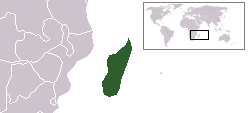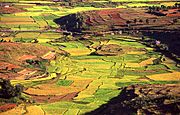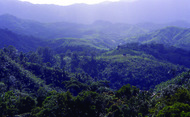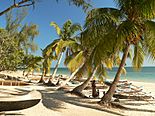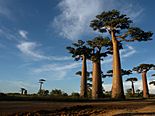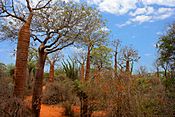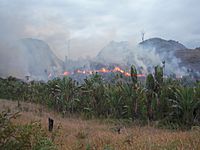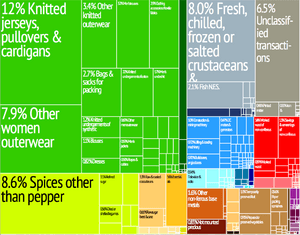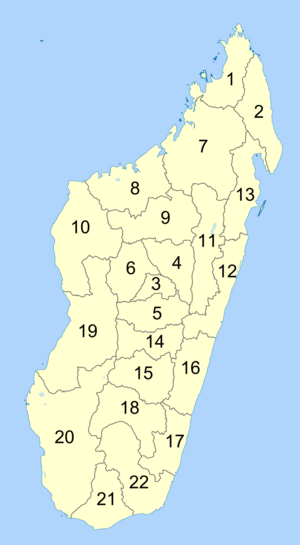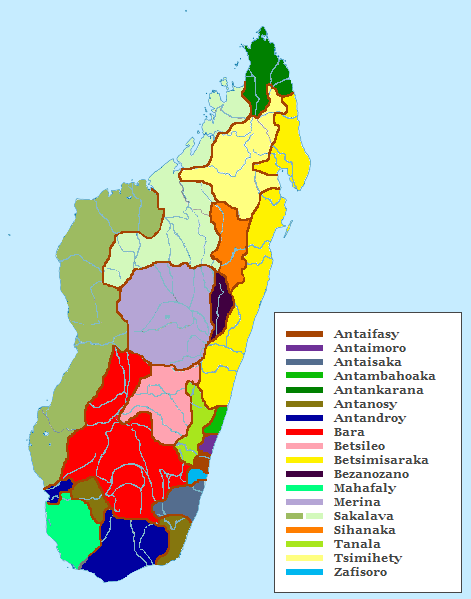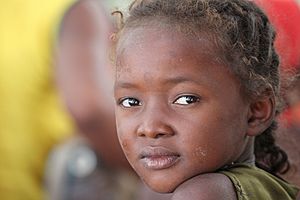Madagascar facts for kids
Quick facts for kids
Republic of Madagascar
|
|
|---|---|
|
|
|
|
Motto:
|
|
|
Anthem: Ry Tanindrazanay malala ô! (Malagasy)
Ô Terre de nos ancêtres bien-aimés! (French) "Oh, land of our beloved ancestors!" |
|
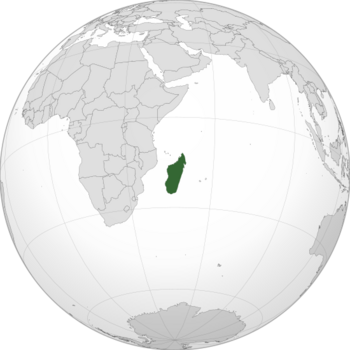
Location of Madagascar (dark green)
|
|
| Capital and largest city
|
Antananarivo 18°55′S 47°31′E / 18.917°S 47.517°E |
| Official languages | Malagasy • French |
| Ethnic groups
(2017)
|
|
| Religion
(2020)
|
|
| Demonym(s) | Malagasy |
| Government | Unitary semi-presidential republic |
| Andry Rajoelina | |
| Christian Ntsay | |
| Legislature | Parliament |
| Senate | |
| National Assembly | |
| Formation | |
|
• Kingdom
|
c. 1540 |
|
• French colony
|
6 August 1896 |
|
• Republic proclaimed
|
14 October 1958 |
| 26 June 1960 | |
| Area | |
|
• Total
|
592,796 km2 (228,880 sq mi) (46th) |
|
• Water
|
5,501 km2 (2,124 sq mi) |
|
• Water (%)
|
0.9% |
| Population | |
|
• 2024 estimate
|
31,964,956 (49th) |
|
• Density
|
55/km2 (142.4/sq mi) |
| GDP (PPP) | 2023 estimate |
|
• Total
|
|
|
• Per capita
|
|
| GDP (nominal) | 2023 estimate |
|
• Total
|
|
|
• Per capita
|
|
| Gini (2012) | ▼ 42.6 medium |
| HDI (2022) | low · 177th |
| Currency | Ariary (MGA) |
| Time zone | UTC+3 (EAT) |
|
• Summer (DST)
|
UTC+3 (not observed) |
| Date format | dd/mm/yyyy |
| Driving side | right |
| Calling code | +261 |
| ISO 3166 code | MG |
| Internet TLD | .mg |
Madagascar is a large island nation in the Indian Ocean, off of the east coast of Africa. Twenty-two million people live there; its capital is Antananarivo. It is the world's fourth largest island.
The official languages are Malagasy and French.
Geologists think that about two million years ago, Madagascar was a part of a big landmass that included what is now the continent of Africa, but it broke off. Madagascar would later break off of the Indian subcontinent.
Contents
History
Following the prehistoric breakup of the supercontinent Gondwana, Madagascar split from Africa during the Early Jurassic, around 180 million years ago, and split from the Indian subcontinent around 90 million years ago, allowing native plants and animals to evolve in relative isolation; consequently, it is a biodiversity hotspot and one of the world's 17 megadiverse countries, with over 90% of wildlife being endemic. The island has a subtropical to tropical maritime climate. Madagascar was first settled during or before the mid-first millennium AD by Austronesian peoples, presumably arriving on outrigger canoes from present-day Indonesia. These were joined around the ninth century AD by Bantu migrants crossing the Mozambique Channel from East Africa. Other groups continued to settle on Madagascar over time, each one making lasting contributions to Malagasy cultural life. Consequently, there are 18 or more classified peoples of Madagascar, the most numerous being the Merina of the central highlands.
Until the late 18th century, the island of Madagascar was ruled by a fragmented assortment of shifting sociopolitical alliances. Beginning in the early 19th century, most of it was united and ruled as the Kingdom of Madagascar by a series of Merina nobles. The monarchy was ended in 1897 by the annexation by France, from which Madagascar gained independence in 1960. The country has since undergone four major constitutional periods, termed republics, and has been governed as a constitutional democracy since 1992. Following a political crisis and military coup in 2009, Madagascar underwent a protracted transition towards its fourth and current republic, with constitutional governance being restored in January 2014.
Geography
At 592,800 square kilometres (228,900 sq mi), Madagascar is the world's 47th largest country and the fourth-largest island. The country lies mostly between latitudes 12°S and 26°S, and longitudes 43°E and 51°E. Neighboring islands include the French territory of Réunion and the country of Mauritius to the east, as well as the state of Comoros and the French territory of Mayotte to the north west. The nearest mainland state is Mozambique, located to the west.
The prehistoric breakup of the supercontinent Gondwana separated the Madagascar–Antarctica–India landmass from the Africa–South America landmass around 135 million years ago. Madagascar later split from India about 88 million years ago, allowing plants and animals on the island to evolve in relative isolation. Along the length of the eastern coast runs a narrow and steep escarpment containing much of the island's remaining tropical lowland forest.
To the west of this ridge lies a plateau in the center of the island ranging in altitude from 750 to 1,500 m (2,460 to 4,920 ft) above sea level. These central highlands, traditionally the homeland of the Merina people and the location of their historic capital at Antananarivo, are the most densely populated part of the island and are characterized by terraced, rice-growing valleys lying between grassy hills and patches of the subhumid forests that formerly covered the highland region. To the west of the highlands, the increasingly arid terrain gradually slopes down to the Mozambique Channel and mangrove swamps along the coast.
Madagascar's highest peaks rise from three prominent highland massifs: Maromokotro 2,876 m (9,436 ft) in the Tsaratanana Massif is the island's highest point, followed by Boby Peak 2,658 m (8,720 ft) in the Andringitra Massif, and Tsiafajavona 2,643 m (8,671 ft) in the Ankaratra Massif. To the east, the Canal des Pangalanes is a chain of man-made and natural lakes connected by canals built by the French just inland from the east coast and running parallel to it for some 600 km (370 mi).
The western and southern sides, which lie in the rain shadow of the central highlands, are home to dry deciduous forests, spiny forests, and deserts and xeric shrublands. Due to their lower population densities, Madagascar's dry deciduous forests have been better preserved than the eastern rain forests or the original woodlands of the central plateau. The western coast features many protected harbors, but silting is a major problem caused by sediment from the high levels of inland erosion carried by rivers crossing the broad western plains.
Climate

The combination of southeastern trade winds and northwestern monsoons produces a hot rainy season (November–April) with frequently destructive cyclones, and a relatively cooler dry season (May–October). Rain clouds originating over the Indian Ocean discharge much of their moisture over the island's eastern coast; the heavy precipitation supports the area's rainforest ecosystem. The central highlands are both drier and cooler while the west is drier still, and a semi-arid climate prevails in the southwest and southern interior of the island.
Tropical cyclones annually cause damage to infrastructure and local economies as well as loss of life. In 2004 Cyclone Gafilo became the strongest cyclone ever recorded to hit Madagascar. The storm killed 172 people, left 214,260 homeless and caused more than US$250 million in damage.
Biodiversity and conservation
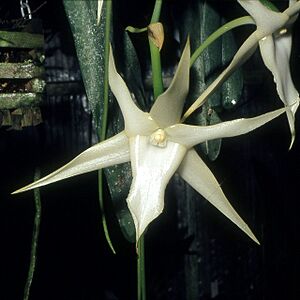
As a result of the island's long isolation from neighbouring continents, Madagascar is home to various endemic plants and animals found nowhere else on Earth. Approximately 90% of all plant and animal species found in Madagascar are endemic. This distinctive ecology has led some ecologists to refer to Madagascar as the "eighth continent", and the island has been classified by Conservation International as a biodiversity hotspot. Madagascar is classed as one of 17 megadiverse countries. The country is home to seven terrestrial ecoregions: Madagascar lowland forests, Madagascar subhumid forests, Madagascar dry deciduous forests, Madagascar ericoid thickets, Madagascar spiny forests, Madagascar succulent woodlands, and Madagascar mangroves.
More than 80 percent of Madagascar's 14,883 plant species are found nowhere else in the world, including five plant families. The family Didiereaceae, composed of four genera and 11 species, is limited to the spiny forests of southwestern Madagascar. Four-fifths of the world's Pachypodium species are endemic to the island. Three-fourths of Madagascar's 860 orchid species are found here alone, as are six of the world's nine baobab species. The island is home to around 170 palm species, three times as many as on all of mainland Africa; 165 of them are endemic. Many native plant species are used as herbal remedies for a variety of afflictions. The drugs vinblastine and vincristine are vinca alkaloids, used to treat Hodgkin lymphoma, leukemia, and other cancers, were derived from the Madagascar periwinkle. The traveler's palm, known locally as ravinala and endemic to the eastern rain forests, is highly iconic of Madagascar and is featured in the national emblem as well as the Air Madagascar logo.
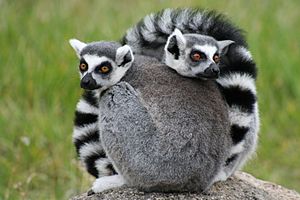
Like its flora, Madagascar's fauna is diverse and exhibits a high rate of endemism. Lemurs have been characterized as "Madagascar's flagship mammal species" by Conservation International. In the absence of monkeys and other competitors, these primates have adapted to a wide range of habitats and diversified into numerous species. As of 2012[update], there were officially 103 species and subspecies of lemur, 39 of which were described by zoologists between 2000 and 2008. They are almost all classified as rare, vulnerable, or endangered. At least 17 species of lemur have become extinct since humans arrived on Madagascar, all of which were larger than the surviving lemur species.
A number of other mammals, including the catlike fossa, are endemic to Madagascar. Over 300 species of birds have been recorded on the island, of which over 60 percent (including four families and 42 genera) are endemic. The few families and genera of reptiles that have reached Madagascar have diversified into more than 260 species, with over 90 percent of these being endemic (including one endemic family). The island is home to two-thirds of the world's chameleon species, including the smallest known.
Endemic fish of Madagascar include two families, 15 genera and over 100 species, primarily inhabiting the island's freshwater lakes and rivers. Although invertebrates remain poorly studied in Madagascar, researchers have found high rates of endemism among the known species. All 651 species of terrestrial snail are endemic, as are a majority of the island's butterflies, scarab beetles, lacewings, spiders, and dragonflies.
Madagascar's varied fauna and flora are endangered by human activity. Since the arrival of humans around 2,350 years ago, Madagascar has lost more than 90 percent of its original forest. This forest loss is largely fueled by tavy ("fat"), a traditional slash-and-burn agricultural practice imported to Madagascar by the earliest settlers. Malagasy farmers embrace and perpetuate the practice not only for its practical benefits as an agricultural technique, but for its cultural associations with prosperity, health and venerated ancestral custom (fomba malagasy). As human population density rose on the island, deforestation accelerated beginning around 1,400 years ago. By the 16th century, the central highlands had been largely cleared of their original forests. More recent contributors to the loss of forest cover include the growth in cattle herd size since their introduction around 1,000 years ago, a continued reliance on charcoal as a fuel for cooking, and the increased prominence of coffee as a cash crop over the past century. Madagascar had a 2019 Forest Landscape Integrity Index mean score of 4.63/10, ranking it 119th globally out of 172 countries.
According to a conservative estimate, about 40 percent of the island's original forest cover was lost from the 1950s to 2000, with a thinning of remaining forest areas by 80 percent. In addition to traditional agricultural practice, wildlife conservation is challenged by the illicit harvesting of protected forests, as well as the state-sanctioned harvesting of precious woods within national parks. Although banned by then-President Marc Ravalomanana from 2000 to 2009, the collection of small quantities of precious timber from national parks was re-authorized in January 2009 and dramatically intensified under the administration of Andry Rajoelina as a key source of state revenues to offset cuts in donor support following Ravalomanana's ousting.
Invasive species have likewise been introduced by human populations. Following the 2014 discovery in Madagascar of the Asian common toad, a relative of a toad species that has severely harmed wildlife in Australia since the 1930s, researchers warned the toad could "wreak havoc on the country's unique fauna." Habitat destruction and hunting have threatened many of Madagascar's endemic species or driven them to extinction. The island's elephant birds, a family of endemic giant ratites, became extinct in the 17th century or earlier, most probably because of human hunting of adult birds and poaching of their large eggs for food. Numerous giant lemur species vanished with the arrival of human settlers to the island, while others became extinct over the course of the centuries as a growing human population put greater pressures on lemur habitats and, among some populations, increased the rate of lemur hunting for food. A July 2012 assessment found that the exploitation of natural resources since 2009 has had dire consequences for the island's wildlife: 90 percent of lemur species were found to be threatened with extinction, the highest proportion of any mammalian group. Of these, 23 species were classified as critically endangered. A 2023 study published in Nature Communications found that 120 of the 219 mammal species only found on Madagascar are threatened with extinction.
In 2003, Ravalomanana announced the Durban Vision, an initiative to more than triple the island's protected natural areas to over 60,000 km2 (23,000 sq mi) or 10 percent of Madagascar's land surface. As of 2011[update], areas protected by the state included five Strict Nature Reserves (Réserves Naturelles Intégrales), 21 Wildlife Reserves (Réserves Spéciales) and 21 National Parks (Parcs Nationaux). In 2007 six of the national parks were declared a joint World Heritage Site under the name Rainforests of the Atsinanana. These parks are Marojejy, Masoala, Ranomafana, Zahamena, Andohahela and Andringitra. Local timber merchants are harvesting scarce species of rosewood trees from protected rainforests within Marojejy National Park and exporting the wood to China for the production of luxury furniture and musical instruments.
Economy
Agriculture is a big part of the economy in Madagascar, including the growing of coffee and vanilla. Madagascar sells more vanilla than any other country in the world. Madagascar also makes money from tourism.
Administrative divisions
Madagascar is subdivided into 22 regions (faritra). The regions are further subdivided into 119 districts, 1,579 communes, and 17,485 fokontany.
| New regions | Former provinces |
Area in km2 |
Population 2018 |
|---|---|---|---|
| Diana | Antsiranana | 19,993 | 889,962 |
| Sava | Antsiranana | 23,794 | 1,123,772 |
| Itasy | Antananarivo | 6,579 | 898,549 |
| Analamanga | Antananarivo | 17,346 | 3,623,925 |
| Vakinankaratra | Antananarivo | 17,884 | 2,079,659 |
| Bongolava | Antananarivo | 18,096 | 670,993 |
| Sofia (7) | Mahajanga | 50,973 | 1,507,591 |
| Boeny | Mahajanga | 31,250 | 929,312 |
| Betsiboka | Mahajanga | 28,964 | 393,278 |
| Melaky | Mahajanga | 40,863 | 308,944 |
| Alaotra Mangoro | Toamasina | 27,846 | 1,249,931 |
| Atsinanana | Toamasina | 22,031 | 1,478,472 |
| Analanjirofo | Toamasina | 21,666 | 1,150,089 |
| Amoron'i Mania | Fianarantsoa | 16,480 | 837,116 |
| Haute-Matsiatra | Fianarantsoa | 20,820 | 1,444,587 |
| Vatovavy-Fitovinany | Fianarantsoa | 20,740 | 1,440,657 |
| Atsimo-Atsinanana | Fianarantsoa | 16,632 | 1,030,404 |
| Ihorombe | Fianarantsoa | 26,046 | 418,520 |
| Menabe | Toliara | 48,814 | 692,463 |
| Atsimo-Andrefana | Toliara | 66,627 | 1,797,894 |
| Androy | Toliara | 18,949 | 900,235 |
| Anosy | Toliara | 29,505 | 809,051 |
| Totals | 591,896 | 25,674,196 |
Government
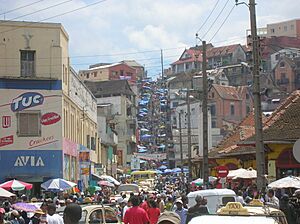
Madagascar is a semi-presidential representative democratic multi-party republic, wherein the popularly elected president is the head of state and selects a prime minister, who recommends candidates to the president to form his cabinet of ministers. According to the constitution, executive power is exercised by the government while legislative power is vested in the ministerial cabinet, the Senate and the National Assembly, although in reality these two latter bodies have very little power or legislative role. The constitution establishes independent executive, legislative and judicial branches and mandates a popularly elected president limited to three five-year terms.
The public directly elects the president and the 151 members of the National Assembly to five-year terms. All 18 members of the Senate serve six-year terms, with 12 senators elected by local officials and 6 appointed by the president.
At the local level, the island's 22 provinces are administered by a governor and provincial council. Provinces are further subdivided into regions and communes. The judiciary is modeled on the French system, with a High Constitutional Court, High Court of Justice, Supreme Court, Court of Appeals, criminal tribunals, and tribunals of first instance. The courts, which adhere to civil law, lack the capacity to quickly and transparently try the cases in the judicial system, often forcing defendants to pass lengthy pretrial detentions in unsanitary and overcrowded prisons.
Antananarivo is the administrative capital and largest city of Madagascar.
Demographics
In 2024, the population of Madagascar was estimated at 32 million, up from 2.2 million in 1900. The annual population growth rate in Madagascar was approximately 2.4% in 2024.
Ethnic groups
The Malagasy ethnic group forms over 90 percent of Madagascar's population and is typically divided into 18 ethnic subgroups. Recent DNA research revealed that the genetic makeup of the average Malagasy person constitutes an approximately equal blend of Southeast Asian, Oceanian and East African genes, although the genetics of some communities show a predominance of Southeast Asian or East African origins or some Arab, Indian, or European ancestry.
| Malagasy ethnic subgroups | Regional concentration |
|---|---|
| Antankarana, Sakalava, Tsimihety | Former Antsiranana Province; north and northwestern coasts |
| Sakalava, Vezo | Former Mahajanga Province; western coast |
| Betsimisaraka, Sihanaka, Bezanozano | Former Toamasina Province; eastern coast |
| Merina | Former Antananarivo Province; central highlands |
| Betsileo, Antaifasy, Antambahoaka, Antaimoro, Antaisaka, Tanala | Former Fianarantsoa Province; southeastern coast |
| Mahafaly, Antandroy, Antanosy people, Bara, Vezo | Former Toliara Province; southern inland regions and coast |
Largest cities
Template:Largest cities of Madagascar
Languages
The Malagasy language is of Malayo-Polynesian origin and is generally spoken throughout the island.
French became the official language during the colonial period, when Madagascar came under the authority of France. In the first national Constitution of 1958, Malagasy and French were named the official languages of the Malagasy Republic. Madagascar is a francophone country, and French is mostly spoken as a second language among the educated population and used for international communication.
Among the upper class in large cities, French is spoken as a native language.
The Constitution of 2007 recognised three official languages, Malagasy, French, and English. A fourth Constitution, adopted in 2010 following a referendum, recognised only Malagasy and French.
Religion
Christianity is the most widely professed religion in Madagascar. In 2020, Muslims constituted 2% of the population of Madagascar. They are largely concentrated in the northwestern provinces of Mahajanga and Antsiranana.
Education

Prior to the 19th century, all education in Madagascar was informal and typically served to teach practical skills as well as social and cultural values, including respect for ancestors and elders. The first formal European-style school was established in 1818 at Toamasina by members of the London Missionary Society (LMS). The LMS was invited by King Radama I to expand its schools throughout Imerina to teach basic literacy and numeracy to aristocratic children. The schools were closed by Ranavalona I in 1835, but reopened and expanded in the decades after her death.
By the end of the 19th century, Madagascar had the most developed and modern school system in pre-colonial Sub-Saharan Africa. Access to schooling was expanded in coastal areas during the colonial period, with French language and basic work skills becoming the focus of the curriculum. During the post-colonial First Republic, a continued reliance on French nationals as teachers, and French as the language of instruction, displeased those desiring a complete separation from the former colonial power. Consequently, under the socialist Second Republic, French instructors and other nationals were expelled, Malagasy was declared the language of instruction, and a large cadre of young Malagasy were rapidly trained to teach at remote rural schools under the mandatory two-year national service policy.
This policy, known as malgachization, coincided with a severe economic downturn and a dramatic decline in the quality of education. Those schooled during this period generally failed to master the French language or many other subjects and struggled to find employment, forcing many to take low-paying jobs in the informal or black market that mired them in deepening poverty. Excepting the brief presidency of Albert Zafy, from 1992 to 1996, Ratsiraka remained in power from 1975 to 2001 and failed to achieve significant improvements in education throughout his tenure.
Education was prioritized under the Ravalomanana administration (2002–09), and is currently free and compulsory from ages 6 to 13. The primary schooling cycle is five years, followed by four years at the lower secondary level and three years at the upper secondary level. During Ravalomanana's first term, thousands of new primary schools and additional classrooms were constructed, older buildings were renovated, and tens of thousands of new primary teachers were recruited and trained. Primary school fees were eliminated, and kits containing basic school supplies were distributed to primary students.
Government school construction initiatives have ensured at least one primary school per fokontany and one lower secondary school within each commune. At least one upper secondary school is located in each of the larger urban centers. The three branches of the national public university are located at Antananarivo, Mahajanga, and Fianarantsoa. These are complemented by public teacher-training colleges and several private universities and technical colleges.
As a result of increased educational access, enrollment rates more than doubled between 1996 and 2006. However, education quality is weak, producing high rates of grade repetition and dropout. Education policy in Ravalomanana's second term focused on quality issues, including an increase in minimum education standards for the recruitment of primary teachers from a middle school leaving certificate (BEPC) to a high school leaving certificate (BAC), and a reformed teacher training program to support the transition from traditional didactic instruction to student-centered teaching methods to boost student learning and participation in the classroom. Public expenditure on education was 2.8 percent of GDP in 2014. The literacy rate is estimated at 64.7%.
Madagascar was ranked 110th in the Global Innovation Index in 2024.
Culture
Each of the many ethnic subgroups in Madagascar adhere to their own set of beliefs, practices and ways of life that have historically contributed to their unique identities. However, there are a number of core cultural features that are common throughout the island, creating a strongly unified Malagasy cultural identity. In addition to a common language and shared traditional religious beliefs around a creator god and veneration of the ancestors, the traditional Malagasy worldview is shaped by values that emphasize fihavanana (solidarity), vintana (destiny), tody (karma), and hasina, a sacred life force that traditional communities believe imbues and thereby legitimates authority figures within the community or family. Other cultural elements commonly found throughout the island include strong kinship ties; a widespread belief in the power of magic, diviners, astrology and witch doctors; and a traditional division of social classes into nobles, commoners, and slaves.
Although social castes are no longer legally recognized, ancestral caste affiliation often continues to affect social status, economic opportunity, and roles within the community. Malagasy people traditionally consult Mpanandro ("Makers of the Days") to identify the most auspicious days for important events such as weddings or famadihana, according to a traditional astrological system introduced by Arabs. Similarly, the nobles of many Malagasy communities in the pre-colonial period would commonly employ advisers known as the ombiasy (from olona-be-hasina, "man of much virtue") of the southeastern Antemoro ethnic group, who trace their ancestry back to early Somali settlers.
The diverse origins of Malagasy culture are evident in its tangible expressions. The most emblematic instrument of Madagascar, the valiha, is a bamboo tube zither carried to Madagascar by early settlers from southern Borneo, and is very similar in form to those found in Indonesia and the Philippines today. Traditional houses in Madagascar are likewise similar to those of southern Borneo in terms of symbolism and construction, featuring a rectangular layout with a peaked roof and central support pillar. Reflecting a widespread veneration of the ancestors, tombs are culturally significant in many regions and tend to be built of more durable material, typically stone, and display more elaborate decoration than the houses of the living. The production and weaving of silk can be traced back to the island's earliest settlers, and Madagascar's national dress, the woven lamba, has evolved into a varied and refined art.
The Southeast Asian cultural influence is also evident in Malagasy cuisine, in which rice is consumed at every meal, typically accompanied by one of a variety of flavorful vegetable or meat dishes. African influence is reflected in the sacred importance of zebu cattle and their embodiment of their owner's wealth, traditions originating on the African mainland.
Sport
A number of traditional pastimes have emerged in Madagascar. Moraingy, a type of hand-to-hand combat, is a popular spectator sport in coastal regions. It is traditionally practiced by men, but women have recently begun to participate. The wrestling of zebu cattle, which is named savika or tolon-omby, is also practiced in many regions. In addition to sports, a wide variety of games are played. Among the most emblematic is fanorona, a board game widespread throughout the Highland regions. According to folk legend, the succession of King Andrianjaka after his father Ralambo was partially the result of the obsession that Andrianjaka's older brother may have had with playing fanorona to the detriment of his other responsibilities.
Western recreational activities were introduced to Madagascar over the past two centuries. Rugby union is considered the national sport of Madagascar. Soccer is also popular. Madagascar has produced a world champion in pétanque, a French game similar to lawn bowling, which is widely played in urban areas and throughout the Highlands. School athletics programs typically include soccer, track and field, judo, boxing, women's basketball and women's tennis. Madagascar sent its first competitors to the Olympic Games in 1964, and has also competed in the African Games. Scouting is represented in Madagascar by its own local federation of three scouting clubs. Membership in 2011 was estimated at 14,905.
Because of its advanced sports facilities, Antananarivo gained the hosting rights for several of Africa's top international basketball events, including the 2011 FIBA Africa Championship, the 2009 FIBA Africa Championship for Women, the 2014 FIBA Africa Under-18 Championship, the 2013 FIBA Africa Under-16 Championship, and the 2015 FIBA Africa Under-16 Championship for Women. Madagascar's national 3x3 basketball team won the gold medal at the 2019 African Games.
Cuisine
Malagasy cuisine reflects the diverse influences of Southeast Asian, African, Oceania, Indian, Chinese, and European culinary traditions. The complexity of Malagasy meals can range from the simple, traditional preparations introduced by the earliest settlers, to the refined festival dishes prepared for the island's 19th-century monarchs. Throughout almost the entire island, the contemporary cuisine of Madagascar typically consists of a base of rice (vary) served with an accompaniment (laoka). The many varieties of laoka may be vegetarian or include animal proteins, and typically feature a sauce flavored with such ingredients as ginger, onion, garlic, tomato, vanilla, coconut milk, salt, curry powder, green peppercorns or, less commonly, other spices or herbs. In parts of the arid south and west, pastoral families may replace rice with maize, cassava, or curds made from fermented zebu milk. A wide variety of sweet and savory fritters as well as other street foods are available across the island, as are diverse tropical and temperate-climate fruits. Locally produced beverages include fruit juices, coffee, herbal teas and teas, and alcoholic drinks such as rum, wine, and beer. Three Horses Beer is the most popular beer on the island and is considered emblematic of Madagascar.
Related pages
Images for kids
-
Malagasy ancestry reflects a blend of Southeast Asian and Bantu (Southeast African) roots.
-
European contact began in 1500 when Portuguese explorer Diogo Dias recorded the island while participating in the 2nd Portuguese India Armadas.
-
King Andrianampoinimerina (1787–1810)
-
Philibert Tsiranana, the first president of Madagascar (1960-72).
See also
 In Spanish: Madagascar para niños
In Spanish: Madagascar para niños




